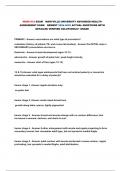NURS 612 EXAM MARYVILLE UNIVERSITY ADVANCED HEALTH
ASSESSMENT EXAM NEWEST 2024-2025 ACTUAL QUESTIONS WITH
DETAILED VERIFIED SOLUTIONS/A+ GRADE
PRIMARY - Answer vaccinations are what type of prevention?
evaluation (history of patient, PE, and review lab studies) - Answer the INITIAL step in
SECONDARY preventative services is.
thelarche - Answer breast development (ages 10-11)
adrenarche - Answer growth of pubic hair, peak height velocity
menarche - Answer start of flow (ages 12-13)
13 & 15-Answer what ages adolescents that have not entered puberty or menarche
should be evaluated for a delay of puberty?
tanner stage 1 -Answer nipple elevation only;
no pubic hair
tanner stage 2 -Answer small raised breast bud;
growth along labia, sparse, lightly pigmented
tanner stage 3 - Answer breast and areola enlarge with no contour difference; hair
increases in amount, darkens, and starts to curl
tanner stage 4 - Answer further enlargement with areola and nipple projecting to form
secondary mound; hair resembles adult type, but not spread to medial thighs
tanner stage 5 - Answer adult contour with areola and breast in same contour, nipple
protruding; hair spreads to medial thighs, adult distribution
,GTPAL Answer gravida - # of pregnancies term - # of pregnancies that reached 37
weeks preterm - # of pregnancies 20-36 weeks abortions - # of spontaneous/induced <20
weeks living children pelvic organ prolapse - stage 1 most distal portion of the prolapse
is >1 cm above the level of the hymen Answer
pelvic organ prolapse - stage 2 - Answer most distal portion of the prolapse is less than
or equal to 1 cm proximal to or distal to the plane of the hymen
pelvic organ prolapse - stage 3 - Answer most distal portion of the prolapse is >1 cm
below the plane of the hymen
pelvic organ prolapse - stage 4 - Answer complete eversion of the total length of the
vagina
tail of spence / upper outer corner - Answer most malignancies of the breast are found
here.
benign prostate hyperplasia - Answer prostate is diffusely smooth and enlarged
prostate cancer - Answer nodular and unusually firm
acute bacterial prostatitis - Answer warm, tense, boggy, very tender
chronic bacterial prostatitis - Answer normal, boggy, or focally indurated
efficacy - Answer how well a method works describes the likelihood that an unintended
pregnancy will occur even when the method is used consistently and exactly as
prescribed
effectiveness - Answer how well a method works in actual practice describes all
unintended pregnancies that occur if a method is not used properly
, lactational amenorrhea - Answer infant suckling during breastfeeding increases
maternal prolactin levels, which in turn inhibit ovulation ****(infant must be <6 months
old!!!)
male sterilization - Answer vasectomy; not effective immediately, usually good after 3
months or 15-20 ejaculations
oral contraceptives - Answer warfarin, insulin, and oral hypoglycemics have decreased
effectiveness in combination with.
medications that decrease the efficacy of oral contraceptives hint= baby!! Answer
phenytoin, phenobarbital, primidone, topiramate carbamazepine, rifampin, St Johns
wart, antiretroviral drugs
medications whose efficacy is modified/altered by concurrent use with oral
contraceptives Answer oral anticoagulants, benzodiazepines, corticosteroids, tricyclic
antidepressants, beta-blockers, and acetaminophen
ABSOLUTE contraindications to combined oral contraception use-Answer hx
thromboembolic disorder, cerebrovascular disease, CAD, breast cancer, estrogen
dependent neoplasia, pregnancy, liver tumor/impaired liver function, long-standing DM,
previous gallstones during pregnancy, undiagnosed AUB, >35 smoking >15 cigs/day,
known thrombophilia, migraine w aura, surgery or ortho injury requiring prolonged
immobilization, acute liver disease, hypersensitivity
red flags of contraceptives-Answer ACHES
A = abd pain
C = chest pain
H = headache
E = eye or speech problem
S = severe leg pain





